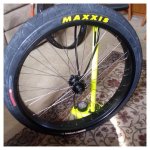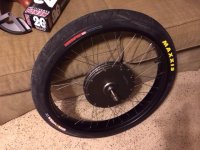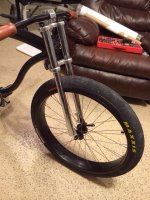danjpendleton
100 W
My wheel builder just sent me a few pics of my 3" wide double wall rims that he is lacing to a clyte hs3540.
He laced the front rim to a 100mm shimano disk hub and it came out great.

But the rear wheel(motor wheel) is obviously a bit different. He said he ordered spoke washers for that rim to strengthen them up.
One concern im having is that there is a slight extra bend in the spoke because of the way the spoke nipples are seated in the rim. He doesnt seem to think it will be much of an issue though. He said he could radially lace it but doesnt think it will be as strong... Heres a pic, what do you guys think???

He laced the front rim to a 100mm shimano disk hub and it came out great.

But the rear wheel(motor wheel) is obviously a bit different. He said he ordered spoke washers for that rim to strengthen them up.
One concern im having is that there is a slight extra bend in the spoke because of the way the spoke nipples are seated in the rim. He doesnt seem to think it will be much of an issue though. He said he could radially lace it but doesnt think it will be as strong... Heres a pic, what do you guys think???





